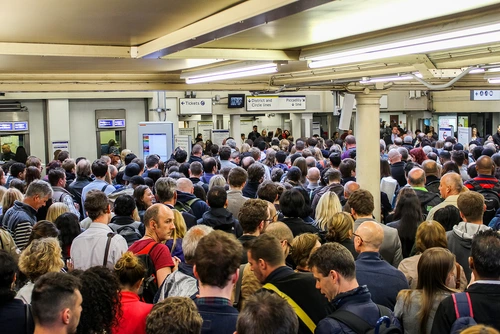
Not all commutes are born equal when it comes to London Underground lines. Some are are hotter than others, some lines have older trains than others, and some lines are faster than others. So what is the truth when it comes to the busiest Tube line?

Part of the problem is that we don’t have all the data we need to make this calculation properly because TfL doesn’t divulge everything. So though you can publicly access a very nerdy document called the London Underground Performance Data Almanac, which is published every year with stats about ‘lost customer hours’ and ‘number of engineering runs’ and suchlike, the data on passenger journeys is rather lacking.
The document will tell you that there were X journeys made on the London Underground network in 20XX–XX; but it won’t break down that data for you by individual line.
It wasn’t always this way, though.
You can still find archived copies of this document from previous years, in which these figures are given. The last set of figures we have are old, and show a total of 1.170 billion journeys across the London Underground network, broken down into individual lines.
This will tell you which line was the busiest in overall terms – how many journeys were taken on it – which runs as follows, from busiest Tube line to least-used.
- Central, 260.9 million
- Northern, 252.3 million
- Jubilee, 213.6 million
- Piccadilly, 210.2 million
- District, 208.3 million
- Victoria, 200.0 million
- Circle and Hammersmith & City lines, 114.6 million
- Bakerloo, 111.1 million
- Metropolitan, 66.8 million
- Waterloo & City, 15.9 million
This raises all sorts of questions about the actual busiest Tube line
One, of course, is why the Circle and Hammersmith & City lines have been lumped together when they perform reasonably different functions and spend a lot of time apart (despite clinging to each other at times).
This way of looking at things is obviously flawed. The Waterloo & City lines, with its two stations and 1.5 miles of track, cannot sensibly be considered in the same terms as the Metropolitan line, with its 34 stations and 41.4 miles of track.
The logical thing to do at this point is to take the total number of passenger journeys per year, and divide it by the number of miles of track there are. Then, you can tell how many people there are per mile of track. Thus, you work out how busy the line is.
Working through this system obviously reveals starkly different results.
- Victoria, 15.1 million per mile
- Waterloo & City, 10.6 million per mile
- Jubilee, 9.5 million per mile
- Bakerloo, 7.7 million per mile
- Northern, 7.0 million per mile
- Central, 5.7 million per mile
- District, 5.2 million per mile
- Piccadilly, 4.7 million per mile
- Circle and Hammermith & City, 4.7 million per mile
- Metropolitan, 1.6 million per mile
So there, apparently, you have it. The Victoria is the busiest, the diddly little Waterloo & City is next, and the dribbly Metropolitan (read: Rural) Line might as well be empty.
Of course, the world has changed a lot since these figures. Perhaps the Metropolitan has got even more empty, or the Bakerloo has thinned out.
At a guess, I’d imagine that the parts of the network serving the eastern inner London boroughs – like the eastern chunk of the Central and District lines – may have become busier, but as we don’t have the facts, that’s nothing more than an idle guess.
It’s also slightly unclear as to how these figures are reached, as beyond station entries and exits, TfL doesn’t actually have that much info on which lines you take – at least, it didn’t until recently when it worked out how to track you if you used the Tube’s Wi-Fi.
So, previously, the Tube didn’t know if you went from Baker Street to Mansion House via one change at Westminster, two changes at Moorgate and Bank/Monument, or some spurious combination of Euston Square, Charing Cross, and Embankment.
After a TfL pilot tracking depersonalised Wi-Fi data, we may soon better understand not only which lines are the busiest, but which specific sections of track are the busiest: it may, for example, emerge that the Victoria line between Oxford Circus and Warren Street is the busiest Tube line.
[Read more: Where are all of London’s abandoned Tube stations?]






